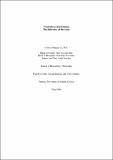| dc.description.abstract | This thesis examines the relationship between painting and mindfulness, including the notion of painting as a mindfulness based intervention. This premise is explored with reference to the aesthetics of Mikel Dufrenne. Dufrenne’s theory, particularly his work, The Phenomenology of Aesthetic Experience makes use of a number of features which characterise mindful practice and reflect the mindful attitude. Dufrenne’s phenomenology of aesthetic experience centres on being present, focused, non-judgemental and attentive to the aesthetic object in order to realise its signification. These concepts are also given primary importance in both Buddhist philosophy of mindfulness and contemporary psychological theories of mindfulness. Dufrenne emphasises the psychological and ontological significance of the aesthetic experience in terms which lend itself ideally to understanding its relation with mindfulness as well as how these experiences complement one another.
Although Dufrenne’s phenomenology of aesthetics does not prioritise painting, the present study will explore painting in particular, against the background of his general aesthetics and illustrate how Dufrenne’s philosophy allows both mindfulness and painting to be understood in more comprehensive terms than that of their meanings considered individually. In this light, painting is understood as a process of mindfulness as well as a product of gesture. This utilises the important notion of style which reflects the artist’s mode of being-in-the-world.
A number of significant features which are highlighted by Dufrenne, in conjunction with their relationship to the concept of mindfulness, will be examined in order to come to an increasingly enlightened understanding of the intrinsic significance of painting. Subject-object reciprocity is one such feature, which accentuates perception and embodiment. It is argued that the introduction of the notion of mindfulness into Dufrenne’s account of aesthetic experience, with special reference to painting, allows us to go beyond and develop Dufrenne’s ideas in directions that Dufrenne, himself, did not envisage. | en_IE |


